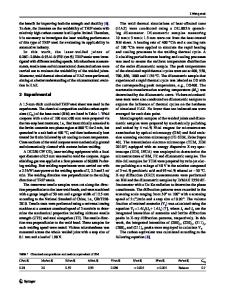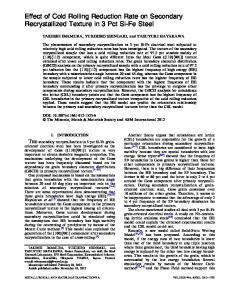Effect of Welding Speed on Texture in Laser-Welded Dual-Phase Steel
- PDF / 5,801,834 Bytes
- 12 Pages / 593.972 x 792 pts Page_size
- 18 Downloads / 294 Views
ODUCTION
TEXTURES are generally represented by the {hkl}huvwi type of notation, where {hkl} refers to the set of planes of the crystal that are parallel to the rolling plane and huvwi refers to the crystallographic directions along the rolling directions (RDs). One of the best methods to understand the orientation or texture of any material is to determine the crystalline orientation distribution function (ODF). In the present study, the notation employed for the description of ODFs is that proposed by Bunge.[1,2] The Euler angles to describe the crystal rotations are u1, F, and u2, and it is quite well known that the two-dimensional view of the u2 = 45 deg section is generally taken as a representative ODF for a steel sample,[3,4] as most of the important texture components, especially for steel, appear in this ODF section.
SUBHAJIT MITRA is with the R&D and Scientific Services, Tata Steel Ltd., Jamshedpur 831001, India and also with the Department of Metallurgical and Materials Engineering, Indian Institute of Technology, Kharagpur 721302, India. Contact e-mail: [email protected], [email protected] KANWER SINGH ARORA and BASUDEV BHATTACHARYA are with the R&D and Scientific Services, Tata Steel Ltd. SHIV BRAT SINGH is with the Department of Metallurgical and Materials Engineering, Indian Institute of Technology. Manuscript submitted October 4, 2019.
METALLURGICAL AND MATERIALS TRANSACTIONS A
The study of texture development in various stages of material processing has become an important part of material characterization during the last couple of decades. For example, the sharpness of {111}hhkli type ND fiber texture, during the processing of low-carbon or ultra-low-carbon steel sheet, gives a clear idea about the deep drawing property of the material. This final texture can be controlled by suitable alloying or by suitably adjusting the process parameters.[3] Numerous investigations on texture development established that a sharp {111} texture is always associated with high normal anisotropy. High intensities around {111}h110i and {111}h112i orientations imply a strong normal direction (ND) fiber or c-fiber, which is highly desirable for the deep drawing properties of a steel sample. In contrast, it was also widely observed that the presence of {001} cleavage planes is the principle cause of brittle fracture as that makes the material prone to slip along the {001} plane at the low critical resolved shear stress. At the same time, several studies reported the formation of {100} solidification texture for steel material.[5–7] This implies that the welded region (fusion zone (FZ) and heat-affected zone (HAZ)) is the weakest portion if subjected to forming. The condition becomes worse for high intensity at the {001}h110i position, which is known as the rotated cube texture.[4,8] For advanced high-strength steels (AHSS), a high intensity close to a {223}h110i or {112}h110i orientation is more common than for a {111}h110i orientation on the RD fiber or a-fiber. Also, {554}h225i and {332}h113i
orientations,
Data Loading...











